Home >> Optics, telescopes
astronomical refracting |
Astronomical refracting telescope

The angle subtended by the object α (alpha), is given by:

The angle subtended by the image β (beta), is given by:

Angular magnification is by definition:
![]()
Substituting for α (alpha) and β (beta) from above,

So for maximum magnification, a telescope is requires a long objective focal length and a short eyepiece focal length.
Terrestrial telescope
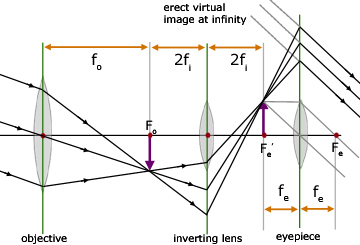
The terrestrial telescope has one more convex lens than an astronomical telescope. The lens is used to invert the intermediary image, while not affecting the image size. This is done by placing the image from the objective at 2f from the lens. Another image is then produced at 2f on the other side of the lens. This image in turn is magnified by the eyepiece.
Galilean telescope
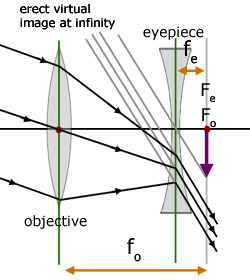
The Galilean telescope produces an erect image from a convex objective len and a concave lens eyepiece.
The telescope is much shorter than both the astronomical and terrestrial telescopes. It's simple design makes it ideal as 'opera' glasses. However, for important astronomical and field work it is severely limited by having a very small 'field of view'.
Reflecting telescopes
Reflecting telescopes all use a concave mirror to produce the primary image.
It is true that refracting telescopes score points by their compactness. However, that aside, reflectors do have a number of advantages:
1) Mirrors can be made metres in diameter. Lenses are limited by their weight, which must be supported around the edges. Approximately one metre in diameter is the practical limit for a lens.
2) Mirrors do not produce chromatic abberation.
3) Mirror glass need not be of as high a purity as a lens glass.
4) Mirrors produce less spherical aberration than lenses.
Newtonian reflector
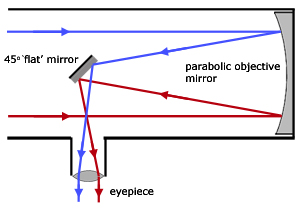
The primary image from the parabolic mirror is directed at 45o from the principal axis by a plane (flat) mirror into an eyepiece located at the side of the telescope.
Cassegrain reflector
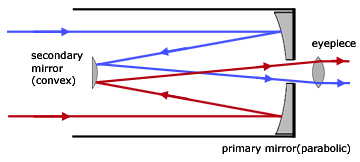
In the Cassegrain reflector light from the primary mirror is reflected backwards from a secondary, convex mirror and directed through the middle of the mirror. here the image is further magnified by an eyepiece.
The Cassegrain has an advantage over a Newtonian by having a large f-number (ratio of focal length to primary mirror diameter). This allows much greater magnification to be attained.
One other important advantage is the length of the telescope. Cassegrains are much shorter, typically less than half the length.
Schmidt-Cassegrain telescope (SCT)
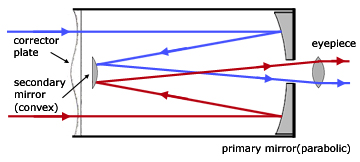
Along with the other advantages of a Cassegrain, a SCT reduces spherical aberration to a minimum. it does this using a 'corrector plate'. This is a specially designed lens, having properties of both convex and concave lenses.
[ About ] [ FAQ ] [ Links ] [ Terms & Conditions ] [ Privacy ] [ Site Map ] [ Contact ]
